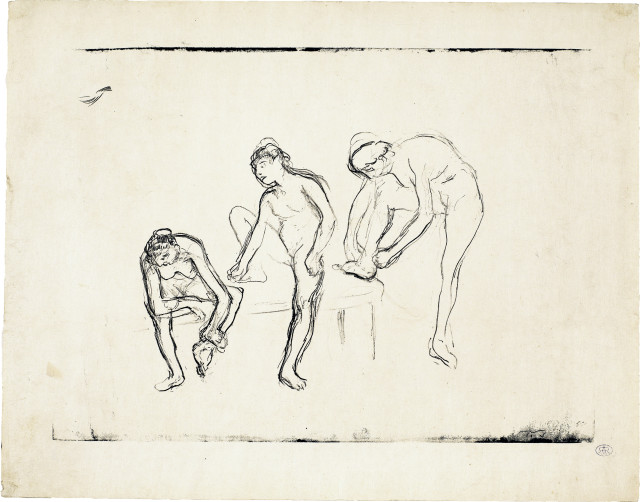- EN
Log in
- Live Auctions
- Past auctions
- More
- Gallery
- Art Dealing
- Publishing
- Kornfeld today
- The Story of Kornfeld
- Information



1834 Paris 1917
Circa 1891
Zincography
20x27,2 cm, plate mark - 25x32 cm, sheet size
Delteil 41 (misleading illustration)
Reed/Shapiro, Boston 1984, 59
Col. Alexis H. Rouart, 1839-1911, Paris, Lugt 2187/a
Henri A. Rouart, Paris
Richard H. Zinser, Forest Hills, Lugt online 5581
Private collection, USA
N.G. Stogdon, Islip, U.K., Edgar Degas, Etchings, Lithographs, Monotypes and Copper plates, Islip 2006, cat. no. 15, ill.
Delteil mentions "Vernis mou" as the technique, Reed/Shapiro refer to "Lithograph from a metal plate". Accoring to the latest research the technique is zincography
Perfect print quality, in perfect condition, with a minimum 2 cm margin around the platemark. On heavy imitation Japanese paper
Probably the rarest graphic work by Edgar Degas, made famous in the copy now available and in a print reworked with pastel and chalk, reproduced by Delteil
In the period around 1888, a new technique won recognition in Paris, zincography, instead of working on a copper plate, a zinc plate was used which is closer to lithography than etching. In 1888 Paul Gauguin created a series of 11 sheets of zincographs, first exhibited at Café Volpini in 1889, printed on yellow paper
Um 1891
Zinkographie
20x27,2 cm, Plattenrand - 25x32 cm, Blattgrösse
Delteil 41 (mit irreführender Reproduktion)
Reed/Shapiro, Boston 1984, 59
Slg. Alexis H. Rouart, Paris, Lugt 2187/a
Henri A. Rouart, Paris
Richard H. Zinser, Forest Hills, Lugt online 5581
Privatbesitz USA
N.G. Stogdon, Edgar Degas, Etchings, Lithographs, Monotypes and Copper plates, Islip, 2006,
Delteil erwähnt als Technik "Vernis mou", Reed/Shapiro nennen "Lithograph from a metal plate". Nach neuerer Erkenntnis handelt es sich um eine Zinkographie
Tadellos in Druckqualität und Erhaltung, mit mindestens 2 cm Papierrand um die Kante der Metallplatte. Auf festem, imitiertem Japan
Die wohl seltenste graphische Arbeit von Edgar Degas, bekannt geworden in dem nun vorliegenden Exemplar und in einem mit Pastell und Kreide überarbeiteten Druck, der von Delteil reproduziert wird
In der Zeitspanne um 1888 setzte sich in Paris eine neue Technik durch, die Zinkographie, die der Lithographie näher steht als einer Radierung. Statt auf einer Kupferplatte wurde auf einer Zinkplatte gearbeitet. Paul Gauguin schuf 1888 eine Folge von 11 Blatt Zinkographien, erstmals ausgestellt im Café Volpini 1889, gedruckt auf gelbem Papier




